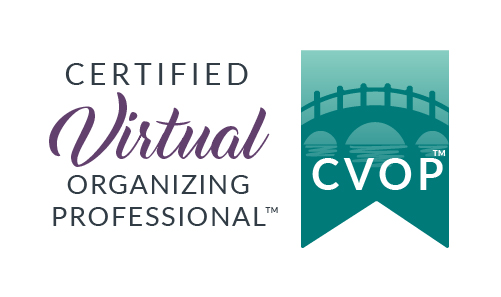In Order Blog
Taming the Paper Monster
I recently completed an organizing job that involved sorting and organizing a large amount of paperwork stored in purses, tote bags, and bins throughout a small apartment. At the end of the job, there were 12 Bankers Boxes filled with papers to be shredded.

Boxes of Unnecessary Papers Ready to be Shredded
Some of the papers I unearthed included: pay stubs dating from 1979 to the present, tax returns from 1980 through last year, grocery shopping lists, old receipts, correspondence, and lots and lots of photographs. I also found a number of uncashed checks and lots and lots of coins totaling hundreds of dollars.
When I ask people about their most overwhelming organizing challenge, paper is cited most often. We all get so much paper. It enters our lives in a variety of forms: paper comes in the daily mail, in our children’s backpacks, and via technology (faxes, email print outs, web search results we print). We also get paperwork (receipts, warranties, and/or manuals) every time we make a purchase and as a result of our healthcare needs (doctor bills, insurance claim forms, EOBs, drug interaction statements, lab work results, etc.). It accumulates rapidly. Personally, I think papers reproduce in the dark at night! Doesn’t it always seem like the paper piles are bigger each day?

Pile of old documents ready for shredding
How Do I Know What to Keep?
One of the main reasons paperwork feels so overwhelming is that many people are uncertain what must be kept, and what can safely be tossed.
There is a lot of paperwork that is redundant, and it only needs to be saved once. For example, once you receive your W2 statement, you can shred the prior year’s pay stubs (unless you are applying for a mortgage in which case you should hold onto the most recent 3 months of stubs). Once you receive your 1098 statement, the previous 12 months of mortgage statements can be shredded. Most report cards are cumulative; the year end card will contain the grades from the previous 3 marking periods, so those from earlier marking periods can be tossed.
Certain documents need to be kept forever, or close to it. For example, year-end investment statements need to be saved for 7 years after the last investment is liquidated so plan to keep for a very long time. Documentation of capital improvements made on your home should be saved for 7 years after you sell that home. So again, most likely saving for the long-haul. Vital documents (such as birth certificates, death certificates, marriage licenses, divorce decrees, military discharge papers) should be kept forever.
Some paperwork needs to be saved for a finite period of time as tax back-up. The general rule of thumb is 7 years (although some accountants say 3 years is sufficient, so check with your financial advisors). In the case of my recent job, we saved the last 7 years of tax returns and tax back-up (2009-2015) and shredded the older documents.
Yet other paperwork doesn’t need to be saved at all (for example, junk mail or the grocery shopping lists I discovered) or should be saved only for a limited period of time (i.e., certain receipts).
If you find yourself inundated with magazines and/or newspapers, consider paring down the number of publications to which you subscribe, consider getting the issues in only a digital format, and definitely toss the old issues.
How Should I Store the Papers I Do Need to Keep?
The answer depends on both what the papers are, and how much storage space you have. It also depends on whether you are comfortable with technologically storing documents through cloud storage and/or scanning documents.
• You definitely do not want to store paperwork on your dining room table or kitchen counters. Create an inbox to corral the current mail. Set up a filing system (traditional filing cabinet, a file box, or a file ottoman are all options) for the papers that need to be saved and accessed.
• Vital documents, and anything with a raised seal, should be stored in paper form and should be accessible. You can certainly scan a copy to store electronically or in the cloud, but these documents should be saved in paper form as well. You may want to keep these documents in a fire-resistant box or safe.
• Tax returns and tax back-up can be saved in either paper or electronic form. If you are saving hard copies, feel free to keep a box of historic tax paperwork on a shelf in a closet, or in the attic or basement. It is unlikely you will need to access this paperwork, except in the case of an audit, so it doesn’t need to take up valuable “real estate” in your filing cabinet.
• Some people prefer using binders rather than file folders. Designate a shelf to store the notebooks, and create one for each major area: Medical, Investments, Household Reference, etc.
• Take advantage of programs such as Evernote, Dropbox or Pinterest for documents such as recipes, a DIY project, or articles about topics of interest, rather than ripping pages from a magazine or printing them from a website. Storing this type of paperwork online makes it easier to access, and takes up less space.
Remember to create regular chunks of time to stay on top of the paperwork (15 minutes twice a week should do it) so it doesn’t become overwhelming. If you have a backlog of paperwork that you can’t bear to tackle on your own, CLICK HERE for help.



















